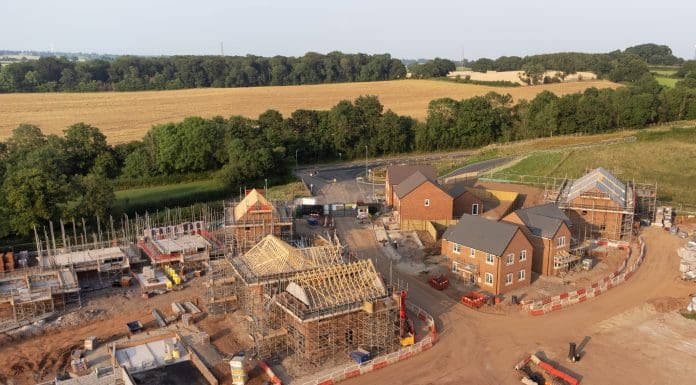
Dr Wei Yang OBE, CEO of the Digital Task Force for Planning and former president of the Royal Town Planning Institute, discusses how digital planning must keep the public in mind
The twenty-first century presents built environment professionals with challenges of a scale and complexity that demand both urgent action and transformative innovation.
From the climate emergency to widening social inequalities, from housing crises to demographic shifts, the world needs approaches that unite rather than divide; that serve the public good rather than sectional interests.
Vision for a Digital National Trust
The Digital Task Force for Planning was founded in response to this imperative, envisaged as a Digital National Trust: a convenor, facilitator, and enabler of digitalisation in mainstream spatial planning. Its mission is simple yet profound: to reinvigorate the planning profession, integrate advanced digital methods and cross-disciplinary knowledge, and cultivate a vibrant, open ecosystem for spatial planning innovation.
In doing so, it seeks to ensure that spatial planning, as an applied social, environmental, and behavioural science, remains a recognised force for good, delivering harmonious environments for people, nature, and society. The Task Force’s report, A Digital Future for Planning – Spatial Planning Reimagined (Batty & Yang, 2022) presented a blueprint for the digital transformation of spatial planning.
As the Digital Task Force evolves from expert panel to innovation-led social enterprise, its vision is to unlock the full public benefit of digital planning, not merely digitising existing practices, but fundamentally transforming how we approach the relationship between people and place in the digital era.
Innovation for the public good
The planning profession’s roots are steeped in innovation and service to the community. Ebenezer Howard, founder of the Garden City movement, aspired to “bring a new civilisation into being, based on service to the community and not on self-interest.” The early pioneers, Geddes, Unwin, and Abercrombie, envisioned planning as both science and art, a discipline blending creative insight, compassion, and selflessness with rigorous evidence and analysis.
At the heart of the planning profession lies the principle of serving the public good. This founding spirit was not born of bureaucratic necessity, but of private endeavour, civic responsibility, and a desire to create a better future. The Garden City model, for example, was not simply a master plan but a social and economic contract: balancing individual freedom with collective cooperation, and weaving together the well-being of people, nature, and society.
As Howard observed, the essence of successful planning lay in understanding human nature – its aspirations, its tendency for short-termism, its capacity for creativity and cooperation. The purpose of planning was, and is, to express the needs and ambitions of communities in the outward form of their towns and cities, to become “the artist of their own cities.”
Tackling pressing challenges and breaking down silos
The world’s grand challenges, climate change, biodiversity loss, housing crises, social inequality, are global and systemic. Addressing them demands more than incremental change: it requires transformative, digitally enabled planning approaches that break down silos and foster joined-up, place-based strategies.
The Intergovernmental Panel on Climate Change (IPCC) has concluded that spatial planning will require the largest systemic changes of any climate adaptation option. Over 45% of the world’s population lives in priority areas for nature conservation; by 2050, the global population is expected to reach 9.8 billion. Urbanisation is slowing but remains high, with nearly 60% projected to live in urban areas by 2070, yet the land covered by the urban-rural continuum will remain twice that of cities.
The complexity of these dynamics demands spatial planning that transcends departmental boundaries and professional silos. Digitally enabled planning, empowered by big data, advanced analytics, and collaborative platforms, can synthesise information from multiple sectors, integrating evidence from environment, health, infrastructure, economy, and society. This joined-up approach is not only more efficient but essential for creating resilient, sustainable communities.
Consider housing strategy: beyond numbers, it must address quality, accessibility, adaptability, and sustainability. Strategic spatial planning, digitally empowered, enables long-term, mission-driven approaches, capturing cross-departmental intelligence and streamlining decision-making. Advanced data analytics allow planners to identify trends and predict impacts, informing not just new construction but retrofitting, energy efficiency, and healthcare.
Digitally enabled planning also fosters real-time communication and transparency, engaging stakeholders and communities in the process. The COVID-19 pandemic has accelerated demand for adaptable, inclusive, and community-focused developments, a trend that can be answered by digital collaboration and evidence-based methodologies.
Similarly, rural-urban symbiosis depends on spatial planning that integrates built and natural environments, balancing land use, resource allocation, and ecological resilience. Digital tools enable modelling and scenario testing, supporting multifunctional land-use strategies and facilitating communication between rural and urban stakeholders.
Digitally enabled place-based spatial planning for the public good
The shift to digitally enabled, place-based planning is more than technological; it is methodological, ethical, and social. The planning profession must play a leading role in setting the agenda and establishing standards, ensuring that digital planning serves the public good.
A digitally enabled integrative methodology involves two interrelated loops:
- Evidence analytics loop: Drawing on multidisciplinary data, digital technology, and scientific knowledge to inform analysis and insight.
- Decision-making loop: Legislative and democratic processes, informed by transparent engagement and evidence.
This circular process redefines each key planning stage, framing questions, creating a shared vision, interconnected plan-making and place-making, approval, implementation, monitoring, and feedback. Digital tools such as BIM, digital twins, participatory GIS, and AI empower planners to iterate, analyse, and co-design with stakeholders in real time.
Such an approach is inherently people-centric, making planning more accessible, engaging, and visual. It breaks down administrative boundaries, supports democratic decision-making, and fosters consensus on collective benefits. Crucially, it enables planners to balance short-term gains with long-term impact, embracing the public good at every stage.
However, digitalisation is not without its limitations. While AI and analytics can accelerate planning processes and enhance data-driven decision-making, they cannot replace the empathy, judgment, and creative intuition of the human planner. Automated systems must be applied thoughtfully, as tools to support, not supplant, the moral and social responsibilities at the heart of the profession.
Planning professionals must therefore lead the transformation, advocating for data standards, infrastructure, upskilling, best practice, and methodology consolidation. Only by cultivating a mature, innovative marketplace can we ensure that digital planning delivers its full public benefit.
Tackling pressing challenges and breaking down silos
As the landscape of housing needs continues to evolve, it is clear that a strategic and digitally empowered approach to planning is essential. At the forefront of this agenda, the housing strategy must thoughtfully address the changing demographics and lifestyles of society. Failure to adapt will not only worsen the current housing crisis but also result in substantial future costs as unsuitable housing types proliferate. Our homes and neighbourhoods should enable multi-generational living, allow people to age in place with dignity, cater to the rise in single-person households, and reflect the UK’s diverse cultural and lifestyle preferences.
The urgency of this transformation is underscored by demographic trends: by 2050, one in four UK residents will be over 60 years old. According to the Office for National Statistics, older adults are increasingly relocating away from major urban centres to rural and coastal communities, putting further strain on already limited health and social care infrastructure. Between 2018 and 2043, rural areas are projected to experience some of the highest growth in the proportion of one-person households headed by older adults. The Centre for Ageing Better highlights that poor-quality housing costs the NHS an estimated £1.4bn every year – a clear signal of the intersection between housing and public health.
These patterns are mirrored in the national housing stock. As of 2023, England had 25.4m homes, yet the 2020-2021 English Housing Survey reported that 3.5m occupied dwellings did not meet the Decent Homes Standard. Alarmingly, 96% of these fell into the lowest bands of the Energy Efficiency Rating, and more than one in five households headed by someone aged 75 or older lived in a non-decent home. Such figures highlight the acute need for housing strategies that embrace not only new construction, but also the retrofitting and refurbishment of existing homes to improve quality, energy efficiency, and accessibility.
The COVID-19 pandemic has accelerated trends that were already reshaping our housing and lifestyle preferences. There is now a surge in demand for flexible living arrangements, access to green spaces, and developments that prioritise community.
Innovative models, such as those supporting co-housing, multi-generational living, and adaptable, work-from-home spaces, are crucial in responding to these shifts. By integrating these models, housing can contribute to community cohesion, resilience, and well-being.
Digitally empowered strategic spatial planning
Meeting these complex demands requires a shift from short-term, siloed thinking to comprehensive, mission-driven, long-term strategies, which is precisely what digitally enabled strategic spatial planning is uniquely positioned to deliver. By leveraging advanced data analytics and digital platforms, planners can synthesise cross-departmental intelligence, streamline processes, and make evidence-based decisions that account not only for the quantity of housing but also its profound impacts on local job markets, infrastructure, sustainability, and the broader environment.
This long-term, integrated approach accelerates housing delivery, provides crucial market certainty, and can drive down costs across the sector. For example, incorporating local renewable energy sources, like geothermal, into new and existing developments not only reduces reliance on fossil fuels but can directly alleviate fuel poverty – cutting energy bills and ensuring resilient energy supplies for vulnerable communities.
Digital collaboration tools further enhance these benefits by enabling real-time engagement between stakeholders – planners, residents, developers, and local authorities. Such transparency and shared responsibility ensure that housing strategies are informed by both robust data and the lived experiences and aspirations of local people.
Enabling well-skilled and well-resourced local authorities
The success of these endeavours hinges not only on strong standards but also on the capacity of local authorities. Place-making standards, which foreground social cohesion, accessibility, sustainability, and quality of life, are vital for ensuring that new developments foster vibrant, inclusive communities.
However, many local authorities currently contend with significant resource and expertise constraints, limiting their ability to implement these forward-thinking, people-centred planning approaches. Investing in local government capabilities is paramount. Empowering local authorities with funding, digital tools, and skilled professionals, versed not only in traditional planning but also in data analytics, collaborative technologies, and sustainable development, will ensure that planning outcomes are both innovative and equitable.
The role of the Digital Planning Directory
A cornerstone of the Digital Task Force for Planning’s work is the Digital Planning Directory, a comprehensive, user-friendly resource listing digital planning service providers for the public and private sectors. Regarded as a milestone moment for the UK’s planning sector, since its launch in January 2025, the Directory has attracted over 24,000 users, growing from 88 to 120 listed companies. Seed-funded by the Ministry of Housing, Communities and Local Government (MHCLG) and strongly supported by key partners, it has quickly become an authoritative resource, frequently cited by councils, researchers, and students.
Currently, the Directory categorises services by expertise, including:
- Community engagement
- Visualisation, 3D modelling, and animation
- GIS and mapping-Environmental and sustainability services
- Planning and urban design
- Land search and assessment
- Application and data management
- Artificial Intelligence and software solutions
- Organisational digital transformation
- Digital Twins
Six months since launch, the Directory has expanded its reach through high-level events from diverse sectors. Looking ahead, its scope will broaden to include a Procurement Resource Hub in autumn 2025 and a Digital Planning Education and Training Listing in early 2026, free resources to support sector-wide learning, skills development, and procurement best practice.
The future vision for the Directory is bold: to become the go-to resource not only for service providers but for procurement, education, and sector-wide collaboration, supporting the mainstreaming of digital planning and the cultivation of an integrated, innovative resource hub.
The next stage: Digital integration in mainstream planning
Five years of focused development and innovation have set the stage for the next chapter: digital integration in mainstream planning. The Directory itself is a living repository of best practices, widely used by councils, academia, and industry. These exemplars support strategic planning, new town development, and the UK government’s wider reform agenda.
Priorities for this next stage include:
- Supporting the establishment of robust data standards for interoperability and quality assurance
- Developing digital infrastructure that supports integrated planning and data sharing-Upskilling planners to provide a digitally empowered workforce
- Promoting and disseminating best practices across the sector
- Consolidating methodologies for consistent, evidence-driven decision-making
- Supporting the growth and maturity of the digital planning marketplace
- Scaling innovation through active engagement with public, private, and academic stakeholders
Integration means embedding digital capabilities at every stage of the planning process – plan-making, engagement, analysis, approval, implementation, and monitoring. Examples from the Directory illustrate how councils and practitioners are already harnessing digital tools to improve efficiency, transparency, and community outcomes.
The journey ahead is one of consolidation and expansion, ensuring that digital planning is not a niche but the standard and that innovation is accessible to all.
What good looks like
As we look ahead, it is essential to harness the transformative power of digital planning to advance the public good in practice. Good planning in the digital era is defined by putting public benefit at the forefront of decisions and actions. It is realised through the integration of science and art, evidence and empathy, technology and human judgement, and in the way planners engage communities in open, transparent processes that foster genuine dialogue and trust.
Achieving resilient, adaptable, and sustainable environments for everyone requires breaking down silos and encouraging cross-sectoral collaboration. Inclusivity and equity must be prioritised, with a particular commitment to those who are vulnerable or marginalised. By nurturing harmonious relationships between people, nature, and society, and upholding a steadfast moral responsibility to truth, beauty, and goodness, planners create a foundation for truly sustainable development.
Digital planning should be recognised not as an end in itself, but as a catalyst that enables the sector to embed best practice, scale positive impact, and accelerate real change. The future of planning lies in integrating these guiding principles into every facet of day-to-day practice. Sector-wide transformation depends on planners embracing innovation, sharing knowledge, and forging partnerships that bridge disciplines and connect policy to action. Together, we can shape environments that reflect the richness and diversity of our communities, foster inclusion, and advance sustainability on a universal scale.
Inspired by the enduring wisdom of Octavia Hill, we are called to perpetuate the spirit, not merely the form, of our profession. Through purposeful action and collaboration, let us commit to leaving a legacy of thriving, resilient places and empowered communities, a legacy that endures for generations to come.
The post Digital planning for the public good appeared first on Planning, Building & Construction Today.

